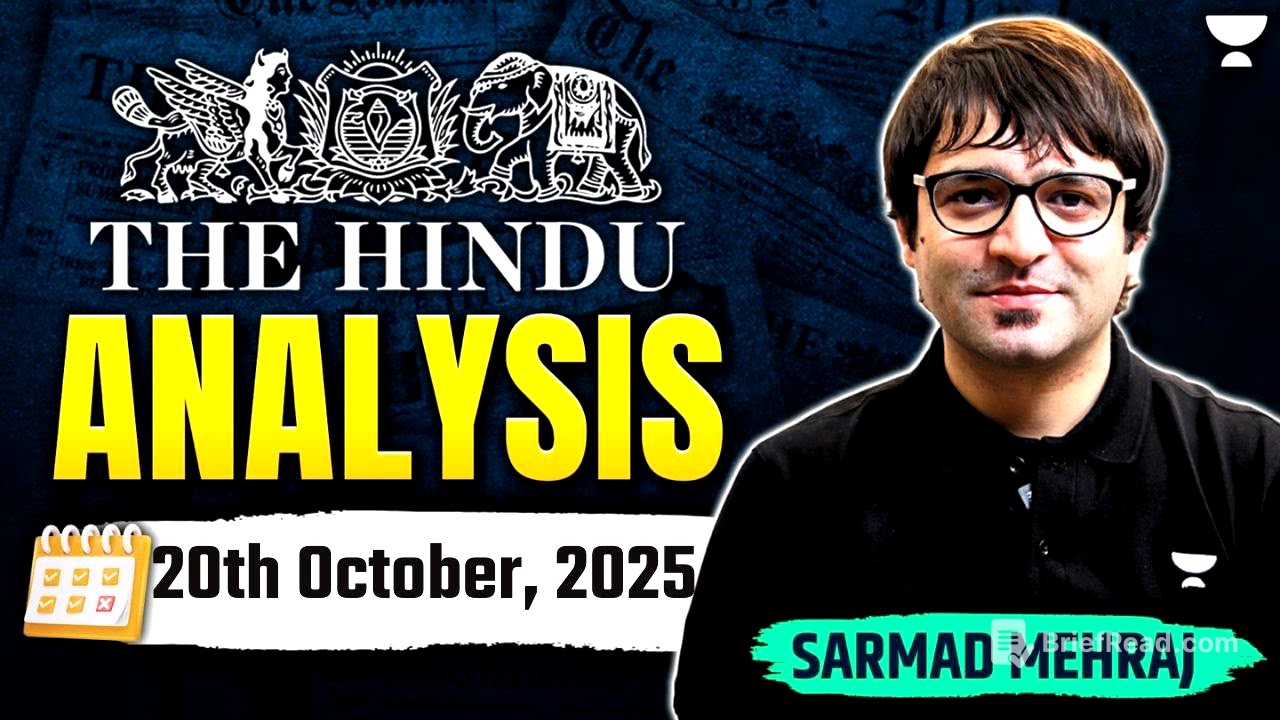TLDR;
This YouTube video by Unacademy IAS: English, presents an analysis of current events from "The Hindu" newspaper. It covers six key topics: the ceasefire agreement between Afghanistan and Pakistan, the debate around green crackers in India, the conflict between state and central governments over education funding, the progress in combating Maoist insurgency in India, the dynamics of the Quad and BRICS alliances, and the theft of French crown jewels from the Louvre Museum. The discussion provides context, historical background, and potential implications for civil service aspirants.
- Afghanistan and Pakistan ceasefire agreement brokered by Qatar and Turkey.
- Green crackers are a step but not a solution to pollution.
- PM Shri scheme and the conflict between state and central governments over education funding.
- Maoist insurgency is about to come to an end in 2026.
- India is common to both quad as well as bricks.
- Thieves steal French crown jewels from the Louvre Museum.
Diwali Offer on Unacademy Plus Subscription [0:16]
Unacademy is offering a Diwali gift to learners: a discount on their Plus subscription, available until the end of Diwali. Interested individuals can visit the website to explore various subscription plans, including Plus, Iconic, Iconic Pro, and Platinum options. By using the code "isEnglish," subscribers can unlock the lowest available subscription fee.
Afghanistan and Pakistan Agree on Ceasefire [1:02]
Pakistan and Afghanistan have agreed to a ceasefire, brokered by Qatar and Turkey, amidst ongoing tensions. The conflict stems from the Durand Line, a border established in 1893 between British India and Afghanistan, which Pakistan recognizes but Afghanistan rejects as a colonial imposition. Historically, Pakistan and Afghanistan were close due to the Taliban, but the relationship strained after 9/11 when Pakistan joined the US-led war on terror, aimed at ousting the Taliban for supporting al-Qaeda. Despite the presence of US and NATO troops in Afghanistan, Pakistan allegedly supported the Taliban, leading to the 2021 Taliban takeover, viewed by some as a Pakistani takeover with an Afghan face.
Taliban Pakistan (TTP) and Accusations [4:37]
The Tehrik-i-Taliban Pakistan (TTP), a separate entity from the Afghan Taliban, aims to establish a rigid Islamic state in Pakistan and has perpetrated numerous terror activities, particularly along the Afghanistan-Pakistan border. Pakistan accuses the Afghan Taliban of supporting the TTP, leading to retaliatory airstrikes by Pakistan in Afghanistan. Amidst these tensions, the Talibani foreign minister was welcomed in India, and diplomatic relations between India and Afghanistan have strengthened, with Pakistan's defense minister accusing Afghanistan of being a proxy of India.
Afghanistan as the Graveyard of Empires and the Great Game [9:38]
Afghanistan is often called the "graveyard of empires" due to the historical failures of foreign powers to maintain control, including Britain, the Soviet Union, and the United States. However, this is a modern geopolitical construct, as Alexander the Great and the Mongols previously ruled Afghan territory for extended periods. During the "Great Game," Afghanistan served as a buffer between the British Empire and the expanding Soviet Union, preventing either power from encroaching on the other's territory in Asia.
Air Pollution and Green Crackers [15:37]
As air quality worsens, Delhi's Chief Minister is advocating for the use of green crackers, which are a step but not a complete solution to pollution. Green crackers were developed through a governmental initiative involving CSIR and NEERI, aiming to reduce toxic metal usage and add dust-suppressing additives. Traditional firecrackers use chemicals like potassium nitrate, barium nitrate, aluminum, sulfur, and charcoal, which release pollutants such as particulate matter, sulfur dioxide, and nitrogen oxide, leading to smog and health issues. Green crackers eliminate barium nitrate, replacing it with less toxic compounds and additives like zeolyte and iron oxide to suppress dust.
Effectiveness and Limitations of Green Crackers [23:49]
NEERI surveys indicate that green crackers result in 30-40% lower PM and gas emissions compared to conventional firecrackers, but they are cleaner, not pollution-free. While eliminating barium nitrate reduces lung and cardiovascular concerns, traces of aluminum, copper, and strontium particles remain. Studies also show the release of ultrafine particles (less than 100 nanometers) that can penetrate deep into the lungs and bloodstream, causing serious health problems. Despite India being a global leader in developing and certifying low-emission firecrackers, counterfeit products challenge their real-world effectiveness.
Debate on Banning Firecrackers and Societal Transformation [28:20]
Some countries have banned fireworks in urban areas due to air quality concerns. In India, the debate involves balancing the right to life (clean environment) under Article 21 with the right to practice any trade or occupation under Article 19(1)(g), including the firecracker industry. Some advocate for a complete ban, while others argue it's an anti-Hindu stance, pointing to other pollution sources like vehicle emissions and stubble burning. A solution requires convincing people that it's about public health, not religious infringement. The concept of "Net Zero" should be viewed as a societal transformation, similar to the Swachh Bharat Abhiyan, which aimed at changing behaviors and societal norms.
Conflict Over Education Funding [34:45]
Education, now under the concurrent list since the 42nd Constitutional Amendment Act of 1976, allows both central and state governments to make laws. The New National Education Policy 2020 faces protests from states like Kerala and Tamil Nadu due to its rigid three-language formula, perceived as Hindi imposition. Schemes like Samagra Shiksha Abhiyan aim to integrate various school-level programs, while PM Shri (Pradhan Mantri Schools for Rising India) seeks to transform 14,500 schools into model institutions with modern infrastructure.
PM Shri Scheme and State Government Concerns [37:26]
The PM Shri scheme is a centrally sponsored initiative where costs are shared between the central and state governments. However, the central government requires states to sign a memorandum of understanding (MoU) to implement the three-language formula to receive funding. Kerala and Tamil Nadu have approached the Supreme Court, alleging that the central government has withheld funds due to their refusal to sign the MoU. Kerala has now decided to sign the MoU to receive approximately 1,400 crore rupees, leading to accusations of succumbing to the central government's pressure.
Maoist Insurgency in India [41:29]
Maoism, once considered a grave internal security threat, focuses on the confiscation of tribal lands by the wealthy, aiming to overthrow the government and implement people's rule. While Maoist insurgency was once rampant in several states, government efforts have reduced their presence to primarily three districts in Chhattisgarh: Sukma, Narayanpur, and Bijapur. The editorial suggests that the credit for this reduction should be shared with security forces and district authorities who have implemented development policies and provided livelihood opportunities to tribals, leading to surrenders and a return to the mainstream.
Strategies to Combat Maoism and Future Prospects [44:52]
The government aims to eradicate Maoism by 2026, building on strategies used in China, Peru, Colombia, Philippines, and Malaysia, which involve development, compassion, and state interventions. The editorial emphasizes the need to address the genuine concerns of tribals through dialogue and peace, even as Maoism nears its end.
Quad and BRICS Alliances [46:55]
The Quadrilateral Security Dialogue (Quad) includes India, Japan, Australia, and the United States, initially formed for tsunami relief but later viewed as a counter to China's rising influence. India maintains it's not a military alliance, but the Quad countries conduct the Malabar naval exercise. BRICS, initially Brazil, Russia, India, and China, expanded to include South Africa and now includes Indonesia, UAE, Iran, Ethiopia and Egypt. Saudi Arabia has not formally joined BRICS to avoid antagonizing the United States.
Tensions and India's Role in Quad and BRICS [49:40]
The United States is concerned about India's participation in BRICS, viewing it as an alliance against the US due to its efforts to reduce reliance on the dollar. India is a member of both Quad and BRICS, and in 2026, India will take over as the chairperson of the BRICS countries. The upcoming ASEAN meet, where the Prime Minister will face leaders from both Quad and BRICS countries, is significant for understanding these dynamics.
Theft at the Louvre Museum and Key Artworks [52:09]
Thieves have targeted the Louvre Museum in Paris, the world's most visited museum and home to Leonardo da Vinci's Mona Lisa. Key artworks to remember include the Winged Victory monument, a 2nd-century BC monument of the goddess of victory Nike, missing its head and arms, displayed on a boat. The museum also houses Venus de Milo, an ancient Greek marble statue celebrating Aphrodite, the goddess of love.









